Accepted Scientific Name: Euphorbia bracteata Jacq.
Pl. Rar. Hort. Schoenbr. 3: 14, t. 276. 1798
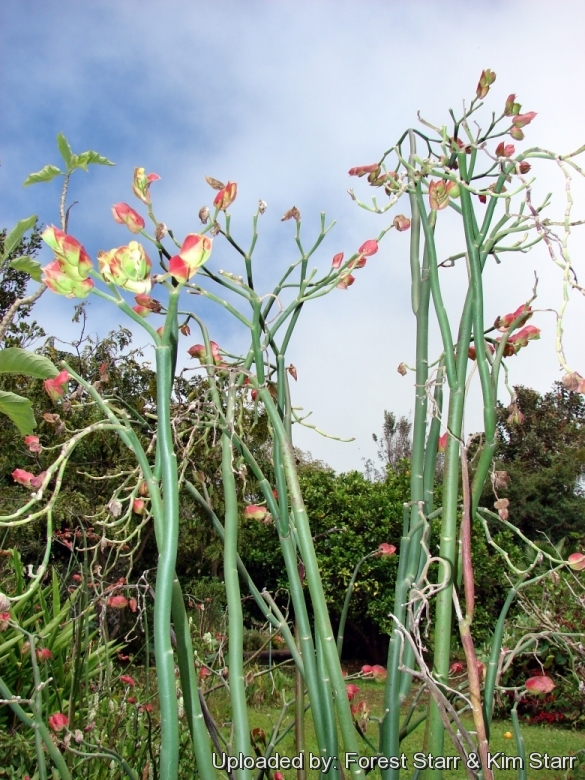
Tithymaloides bracteata (Euphorbia bracteata) Photo by: Forest Starr & Kim Starr
Flowers at Enchanting Floral Gardens of Kula, Maui, Hawaii (USA). April 30, 2009.
Origin and Habitat: Widespread in west Mexico from Sonora to Guerrero.
Altitude: 300-600 m a.s.l.
Habitat: It grow on flat or slightly rolling land and at the edges of dry deciduous woodlands.
Ecology: It is believed that the flower is pollinated by hummingbirds and insects.
Synonyms:
See all synonyms of Euphorbia bracteata
back
Accepted name in llifle Database:Euphorbia bracteata Jacq.Pl. Rar. Hort. Schoenbr. 3: 14, t. 276. 1798Synonymy: 24
back
Common Names include:
ENGLISH: Slipper plant, Candelilla, Tall slipper plant, Slipper spurge
Description: Pedilanthus bracteatusSN|25889]]SN|25889]] (Euphorbia bracteata) is a small evergreen or deciduous shrubs growing to around 1,8 m tall (to 3 m tall in habitat), 0,9-1,2 m wide that branches profusely from the base; It produces abundant flowers (cyathia) with somewhat shoe-shaped reddish-coloured bracts that give this species the common name Slipper Plant. It is related to Euphorbia antisyphilitica.
Stem: Branches, upright, succulent, wax-coated, narrow, cylindrical, green, scabrous or sparsely hairy and leafless before flowering.
Leaves: Just near the branch tips, ovate. 4,5-10 cm long, 25-6 cm wide, with a thick keeled midrib beneath, glabrous to pubescent; petiole 3-4 mm long.
Inflorescence: The inflorescence is a 1-3 branched cyme near the stem's tip. The cyathia (flower structures containing separate male and female parts) are enclosed in rounded reddish pink bracts, ovate, 1,8-4,5 cm long, 1,5-3,5 cm wide. Cyathia curiously shaped pale green to reddish; peduncle 4-8 mmm long. tube 10-16 mm long, spur 10-15 mm long projecting obliquely. broadly blunt: Nectar glands 2; Style up to 14 mm;
Blooming season: In the warmth of late spring and summer.
Fruit: Capsule, subquadrate, shallowly 3- lobed. 10-13 mm in diameter. Peduncle 7-12 mm.
Seed: Ovoid. 5-7 mm long, 4-5 mm wide
Bibliography: Major references and further lectures
1) Forest & Kim Starr “Pedilanthus bracteatus (Slipper plant, candelilla)”. Plants of Hawaii. <http://www.starrenvironmental.com>. Web. 27 Sep. 2014.
2) Debra Lee Baldwin "Succulents Simplified: Growing, Designing, and Crafting with 100 Easy-Care Varieties" Timber Press, 21/May/2013
3) Paul Schultz Martin "Gentry's R’o Mayo Plants: The Tropical Deciduous Forest & Environs of Northwest Mexico" University of Arizona Press, 1998
4)Paul C. Standley "Trees and shrubs of Mexico" Volume 1 Smithsonian Institution, 1967
5) San Marcos Growers “Pedilanthus bracteatus - Tall Slipper plant”. <http://www.smgrowers.com>. Web. 05 Oct. 2014.
6) Urs Eggli, "Illustrated Handbook of Succulent Plants: Dicotyledons" Page 224 Springer Science & Business Media, 2002
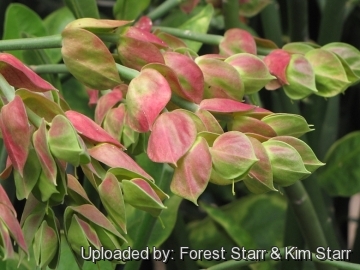 Flowers at Wailuku, Maui, Hawaii (USA). August 03, 2009. (Euphorbia bracteata) Photo by: Forest Starr & Kim Starr
Flowers at Wailuku, Maui, Hawaii (USA). August 03, 2009. (Euphorbia bracteata) Photo by: Forest Starr & Kim Starr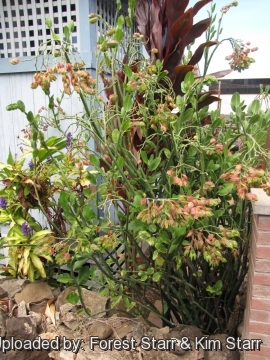 Flowering habit at Wailuku, Maui, Hawaii (USA). August 03, 2009. (Euphorbia bracteata) Photo by: Forest Starr & Kim Starr
Flowering habit at Wailuku, Maui, Hawaii (USA). August 03, 2009. (Euphorbia bracteata) Photo by: Forest Starr & Kim Starr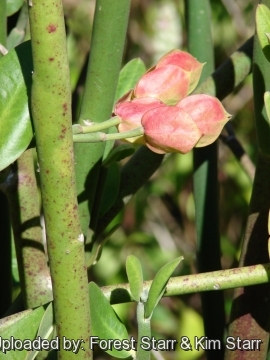 Flower at Enchanting Floral Gardens of Kula, Maui, Hawaii (USA). October 24, 2007. (Euphorbia bracteata) Photo by: Forest Starr & Kim Starr
Flower at Enchanting Floral Gardens of Kula, Maui, Hawaii (USA). October 24, 2007. (Euphorbia bracteata) Photo by: Forest Starr & Kim Starr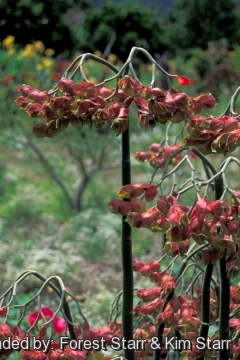 Flowers and fruits at Enchanting Floral Gardens of Kula, Maui, Hawaii (USA). May 29, 1998. (Euphorbia bracteata) Photo by: Forest Starr & Kim Starr
Flowers and fruits at Enchanting Floral Gardens of Kula, Maui, Hawaii (USA). May 29, 1998. (Euphorbia bracteata) Photo by: Forest Starr & Kim Starr Flowers at Enchanting Floral Gardens of Kula, Maui, Hawaii (USA). April 30, 2009. (Euphorbia bracteata) Photo by: Forest Starr & Kim Starr
Flowers at Enchanting Floral Gardens of Kula, Maui, Hawaii (USA). April 30, 2009. (Euphorbia bracteata) Photo by: Forest Starr & Kim StarrSend a photo of this plant.The gallery now contains thousands of pictures, however it is possible to do even more. We are, of course, seeking photos of species not yet shown in the gallery but not only that, we are also looking for better pictures than those already present.
Read More... Cultivation and Propagation: Pedilanthus bracteatusSN|25889]]SN|25889]] (Euphorbia bracteataSN|24074]]SN|24074]]) is a relatively fast grower succulent in frost free zones and also a great container plant for full sun to partial shade. It is probably a winter grower and need water from October, when the new leaves can be seen forming on the growing tip In April the leaves begin to go yellow and drop off, so now it rests quite dry in to summer. But others suggest to water it moderately all year round as it tends to be an opportunistic plant that tend to grow in each time of the year whenever it has enough water in fair weather and rest when temperatures are too hot or too cool and may have several or sometimes no growth cycles in a year. It must be grown very hard in the nursery as close to the natural conditions as possible. This ensures that it keeps its compact habit.
Soil: Give the plant a well drained, airy, growing medium which mainly consists of non organic material such us clay, pumice, lava grit, and only a little peat or leaf-mould.
Irrigation: It prefers to be on the dry side with good but infrequent waterings but looks best with regular watering in hot months. Less water during winter. No water should ever be allowed to stand around the roots. But it adapts to different growing conditions from extreme heat and drought, to high moisture as it has a low rot potential.
Feeding: Feed the plant with slow release fertiliser occasionally.
Re-potting: The plant grows rather slowly in pot. When necessary, re-pot to a slightly bigger pot. The pot should be just slightly bigger than the original pot and with a hole for drainage.
Hardiness: Hardy to approx to -5 degrees Celsius, it is cultivated in open air in the tropical and warm Mediterranean climate, with temperatures which it is good to keep over the 5°C, best 10-12°C, but can withstand light frost for short periods if very dry, in these situations it will better resist if sheltered by the winter rains, seen that the humidity and low temperatures render it more sensitive to rottenness. Plants in containers however, suffered major leaf loss. USDA Zone 9b to 12.
Exposure: Full sun to filtered light (leafy but with fewer flowers in deeper shade).
Maintenance: If the flower bracts dry up and the tip is not showing any blooms, prune about six centimetres of the tip of the stem to encourage new growth. This species do tend to get sort of leggy, which is particularly a problem if grown as a potted plant, and pruning is sometime necessary to shape. Staking is often necessary to prevent the plant from falling or bending over.
A round and sturdy support stake is advisable for a pot of plant with many stems. Use a soft rope or covered wire to tie. Secure the tie to the stake . Loop around the plant or make the figure "8" loosely so that they do not cut the stems. Then tie back to the stake with a knot.
Use: This plant is a fun addition in the garden in the ground or as a container specimen.
Warning: Most species in the Spurge family have white latex, a milky sap in the plant's stems and leaves that is poisonous. Be careful when handling it as the plant may cause skin irritation or allergic reaction.
Propagation: Seed or cutting. It is easy to propagate by cuttings in late spring to summer, just take a tip stem cutting directly into the soil after milky sap has totally flowed out. (preferably dry, loose, extremely well draining soil).















